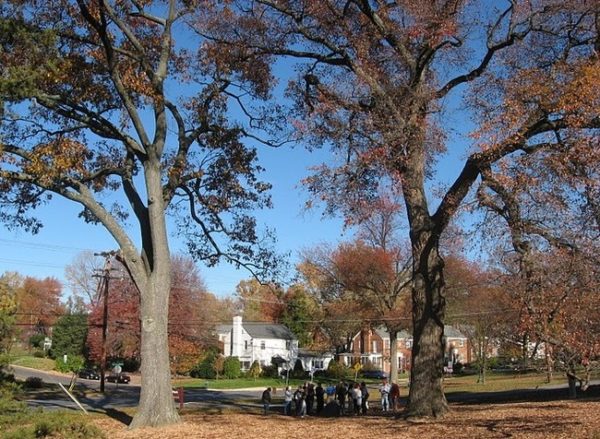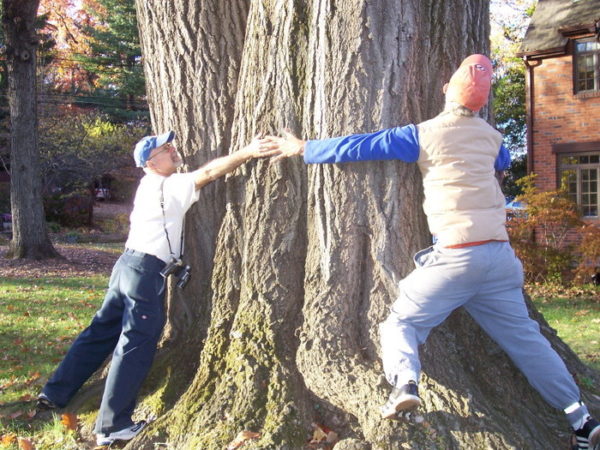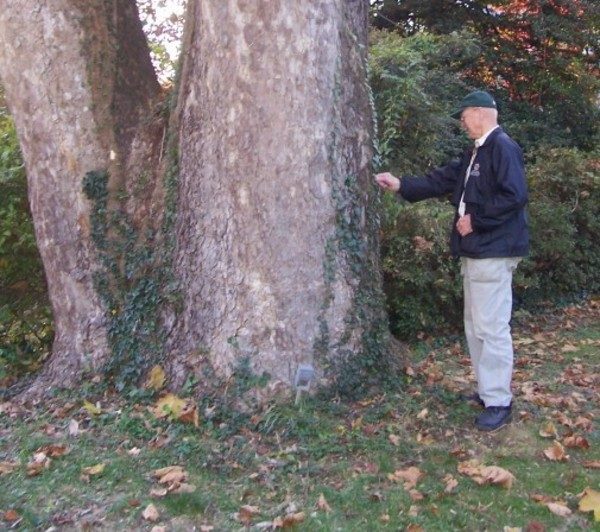Significant Trees of Sligo:
A Driving & Walking Tour
| Led by Mr. Joe Howard November 14, 2010 — Sunday afternoon |
Delighted to be outside in gorgeous autumn weather, some two-dozen adults gathered — by car and by foot and by bike — in the parking lot just north of Dennis Avenue, on the east side of Sligo Creek. Most came having seen the flyer in one of the signboxes along the paved path.
The chair of the Natural History Committee, Laura Mol, welcomed the group on behalf of Friends of Sligo Creek, and introduced leader Joe Howard — a long-time resident of the Sligo watershed, a retired elementary/middle school teacher, a 30-year member of Montgomery County’s Forestry Board, and the pre-eminent champion of “Champion Trees.”
Joe described the concept of champion trees and passed out the current edition of this biennial publication, the 16-page Register of Champion Trees, 2009, Montgomery County, Maryland. Champion trees are of either native or naturalized species and must be at least 13 feet high to qualify for consideration (species new to the Register are often not really the largest in the area, only the first to have been nominated). Measuring champions is a formula combining girth, height, and spread of the branches.
Joe Howard loves trees, and he clearly enjoyed sharing his enthusiasm. As we went from tree to tree — driving in caravan or walking — he urged us to touch the trees, not just look.


For the first stop of the afternoon’s 14, we gathered beneath a giant Black Gum tree along Forest Glen Road, noted as a “Bicentennial Tree,” that is, in 1976 believed to have been alive 200 years ago, in 1776. Like most tree experts, Joe Howard is generally reluctant to speculate very closely on the age of trees, as their growth can vary greatly, depending on light and weather and soil.

Also nearby along Forest Glen, we visited a Sassafras and a Virginia Pine. The former, in this photo below, shows traces of the fall color that illuminated the afternoon so magnificently.

We next journeyed to a Loblolly Pine that stands near the Parkside office of M-NCPPC and then visited a Sawtooth Oak off Brunett Avenue, near the Parkway. It was planted by Parks staff some years ago, long before the Asian species showed its emerging proclivity to invade woodlands and displace other oaks.
Glad to be able to abandon our car caravan and go on foot to the next three trees, we followed a neighborhood footpath through to a house on Bruce Drive — the Howards’s own — with a huge River Birch toward the back. The group paused, however, at the sight of a hand-carved front door, and Joe explained that it had been done by Steve Weitzman (who sculpted in 1992 the “Whispers” piece at the Dennis Avenue Sligo playground and has also done the “Chesapeake Journey” mosaic at the National Harbor, East Potomac Park, DC).

We saw a four-trunked Buckeye, a species more typically found in the Midwestern US, growing along the Parkway and, even closer to Colesville Road, were astonished at the sight of the knees of the Bald Cypress, incongruously lining the west bank of Sligo Creek. This swamp-loving species can grow here, but is said not to reproduce here; the species is also unusual in that it bears needles but the needles shed in the fall (which we expect only of broad-leaved trees). We saw the bald cypress’s golden-brown needles underfoot and, then looking across the Creek, saw them in the tree canopy, highlighted by the late-afternoon sun.
The last set of trees on the tour was in the neighborhood west of Sligo Creek, the Woodside area. (It is the policy of the Champion Tree Register not to provide precise locations for trees, so often in the yards of people’s homes, and we follow that practice here.) In the Woodside neighborhood, we first visited a single-trunked Blackhaw, a viburnum which is typically seen in the Sligo Woods in the form of a multi-stemmed shrub. The next champion was a Red Oak, with a trunk so large that it took four-and-a-half (that is, five) people to reach their joined hands around it. The photo below shows David Blockstein and Jim Baird as part of the oak-embrace.

Also in this neighborhood was an enormous Sycamore, where Joe paused to peel away some ascending English ivy, explaining why the ivy endangers the tree and how, as it grows vertically, it matures and bears berries that the birds then carry into the woodlands, where the ivy overruns wildflowers on the forest floor and further endangers trees into which it climbs.

The afternoon was deepening and, through the massive limbs of the Sycamore, we saw the beauty of a shining half-moon.



